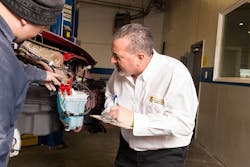“I knew I could do better,” Joe McKenna remembered thinking to himself.
He knew he could better handle a problem most shop owners would gladly welcome: rapid growth. But as McKenna’s operation was growing, his ability to acclimate to the growth was unavailable. He knew something wasn’t right, but he couldn’t see the problem. And the longer he couldn’t find what was wrong, the more his operation was suffering.
The owner of Golden West Collision Center in Sunnyvale, Calif., found himself falling short of cycle time goals, covering a large sum of rental car expenses and enduring the frustration of failing to hit the numbers his insurance partners demanded.
It didn’t help that he thought cycle time and technician efficiency were one and the same.
It wasn’t until a fresh pair of eyes came into the picture that McKenna even began to understand what was really wrong with his shop. After identifying where he went wrong, McKenna was able to cut his 9-day cycle time down—by a third.
The Background
Over the course of 15 years, McKenna’s 22,000-square-foot facility went from 6–7 cars per day to now working on anywhere from 12–14 cars per day.
With a sudden spike in car count and the five DRPs that he participates in kept sending cars over, McKenna’s cycle time went up.
As a longtime Sherwin-Williams customer, McKenna participated in the company’s 20 Group facilitated by Square One Systems. And it was at a 20 Group meeting in 2015 where he began talking to Mike Lanza, manager of business consulting services for Sherwin-Williams.
In October 2016, Lanza visited McKenna’s facility and after a thorough photo assessment, McKenna’s eyes were finally opened as to what was wrong with his shop.
The Problem
As McKenna’s business was growing, his processes weren’t growing with it, making it one of two of the largest problems in the shop. The second-largest issue was the layout of the shop.
After seeing the photos that Lanza took of McKenna’s shop, McKenna was shocked to see how cluttered his shop was.
There were no visuals for the staff, and the flow was all over the place. Cars would keep piling up as techs were swamped in their current work.
In the midst of the lack of organization, McKenna recalls the feeling of hoping that someone would become available to take the cars apart.
With the old process, the car would be halfway assembled, an estimate would be written for it, the estimator would eventually be interrupted for another job, an incomplete supplement would be written—resulting in another supplement down the line, more parts needed to be ordered and so on.
The lack of process caused his sales to go down by 20–30 percent and his cycle time to go up to nine days with only a touch time of 1.5 hours.
The Solution
Since layout and process were his biggest challenges, he tackled those first right after the shop visit in 2016. Along with the revamp, he took care of other aspects of the business that also resulted in much-needed improvement.
Layout: Since organization was lacking in the shop, McKenna began with taking a Google image of his shop from above, starting with the parking lot.
He placed signs of where things should be staged that gave direction of what cars should be parked where.
Within the shop, he designated stalls for reassembly and in-process body work, as well as an area for blueprinting. He had two shops (one for blueprinting and one for bodywork) and he decided to create an opening large enough to drive two cars through rather than driving around the shop. McKenna also created large door openings for parts carts usage.
His layout changes were so drastic that structural beams had to be put in the shop and it cost McKenna $50,000 to complete the project.
Process: Now, there are front office estimators that are solely responsible for sales and customer service, and backend people that ensure the cars keep flowing through the shop.
Visual color coding on cars was implemented, indicating everything from a pre-wash to an express repair.
Parts are now available on the appropriate carts, eliminating the need for techs waiting on the go-ahead from the production manager.
Finally, the blueprinting process has become more thorough with a complete disassembly, the wheel alignment is done before the estimate is finished, and now frame pulling and sheet metal straightening is incorporated before the estimate is written to ensure accuracy.
As a part of improving process, changes also had to happen when it came to meetings, scheduling and technology. McKenna rarely had meetings before, but now conducts “pride meetings” that include everyone in the shop.
Now, McKenna focuses on scheduling units per day versus worrying about the hours of each job. His simplistic approach to scheduling has allowed him to schedule 3–4 more cars per day.
The Aftermath
In just a little over a year, McKenna cut his cycle time by three days, now at a six-day average with a touch time of 2.5 hours.
His sales also improved. In December 2015, the shop was doing $3.8 million. At the end of 2017, the shop hit $4.8 million.
But most importantly, it’s been a less stressful time for McKenna now that everything has fallen into place.
The Takeaway
McKenna knows that not everyone has a large sum of money to invest in a renovation like he did, but he says that you don’t need to because many items can be done for free, like implementing visual cues, eliminating waste up front, color-coding cars, staging bumper racks effectively, mirror matching your parts, etc.
It doesn’t need to be a high-dollar change, he says. It’s just looking to change the problems that keep popping up.
“Being willing to accept personal responsibility for things that aren’t going right and just willing to roll up your sleeves and [do] the work,” McKenna says.
SHOP STATS: GOLDEN WEST COLLISION CENTER Location: SUNNYVALE, CALIF. Operator: Joe McKenna Staff Size: 34 Shop Size: 22,000 sq ft; Annual Revenue;$4.8 million
Expert Advice
—
Lee Rush, manager of business consulting services for Sherwin-Williams, says the greatest erosion of cycle time comes from supplemental delays, whether it’s additional damage discovery after the initial estimate or after a vehicle is put into production.
If you’re a DRP shop and your cycle time is lacking, your performance expectations in the eyes of your DRP relationships are lacking as well.
Most DRP shops are being ranked and tiered based on KPIs, such as cycle time, he says, and since most systems today automatically manage the number of claims you receive, you could be hurting your business directly.
Even if you aren’t a DRP shop, Rush asks, are you worried about throughput? You should be, regardless. The end goal is to increase your units produced with the same overhead costs, equipment and square footage. Just increasing throughput will decrease cycle time.
Although damaged, poor fitting or incorrect parts are real challenges body shops face, a lot of times, shops fail to discover certain damage soon enough to avoid these delays.
Cycle time issues are easily improved if you consider the different types of communication that are necessary in running an efficient operation.
- The Production Meeting: This is crucial to keeping all team members focused on the same agenda on that particular day of production.
- Visual Management: The way you physically stage inventory or vehicles on your lot communicates your priorities through organization.
Everything you do on the production floor needs to have a purpose. Visual management can include where your parts carts are staged to indicate whether a vehicle needs to disassembled, is awaiting refinish, so on, so forth.

